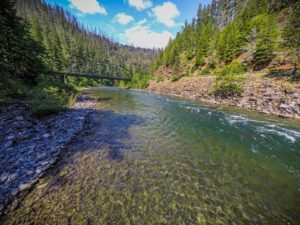
New Clackamas Wild Spring Chinook Broodstock Program Approval “Needs To Be A Priority” For Feds
Editor’s note: Originally posted August 5, 2021 as a Facebook exclusive
Oregon salmon managers and fishing advocates are gnashing at the bit to begin collecting 100-plus wild spring Chinook from a Portland-area river in a bid to rebuild its hatchery run and once-thriving fishery.
They wanted to start in mid-July but have had to wait on final approval from the National Marine Fisheries Service on their hatchery genetic management plan, submitted back in early May 2020, to kickstart the new integrated broodstock program this summer and fall.

“If we don’t get this program underway, we can just write off Clackamas hatchery Chinook sportfishing into eternity,” said local guide Bob Rees this morning.
Right now, he said the fishery is “dead on arrival” as returns of the old segregated hatchery stock, which used upper Willamette basin springers, have petered out, with zero retained in the river by bank and boat anglers during 2019’s season.
The early 2000s provided 1,000-plus annually.
True, hatchery releases have declined from as many as 1.6 million young clipped springers in 2006 to 738,000 in 2014, but critically, smolt-to-adult return percentages have tanked, from as much as 1.5 percent in 2006 to lows of .04 and .02 percent in 2013 and 2014, per the HGMP.
Even armchair biologists should be able to see the futility of “cranking open the ol’ hatchery spigot” at those low rates of return.
On the flip side, the Clackamas’s wild spring Chinook are doing notably better than at some points in the early 2000s, when as few as 941 adults and jacks entered Portland General Electric’s sorting trap at North Fork Dam.
Last year, just under 4,000 did; the mean from 2010-2019 is 2,331, “suggesting that prudent collection of wild fish for broodstock would not significantly impact the population’s viability,” per the HGMP.
PGE’s improvements to its hydropower system are largely credited for the rebound. The fish are trucked to the upper Clack where most of the river’s springer spawning habitat is located.
This year through August 2, some 1,841 wild kings have entered the trap, according to PGE’s latest count, and under the Oregon Department of Fish and Wildlife’s plans, 120 would be collected annually for three years for use as the base “rebuilding” broodstock.
In the following years, the plan calls for 14 females and seven males to be collected annually when at least 1,000 natural-origin springers enter the trap by July 31, increasing to 30 and 15 when a total of 2,000 have arrived, keeping hatchery and wild fish genetically close.
The program would rear up to 1.2 million smolts, nearly all of which would be adipose-fin-clipped. The fish would be released into the Clackamas and Clear and Eagle Creeks.
Rees called rebuilding the run around wild Clackamas springers “a game-changer for the consumptive angling public in the Portland area.”
It’s not unlike what’s done with winter steelhead on the Oregon Coast and, now, on Washington’s Skykomish with South Fork summer-runs.
ODFW biologists could have begun collecting those Chinook from the North Fork Dam trap on July 15, ensuring they kicked off the program with a good genetic “cross section” of the run, but as we’ve seen with plans for numerous other hatchery programs overlapping and including ESA-listed salmon and steelhead runs, NMFS has been frustratingly slow to give that greenlight.
“This needs to be a priority for our federal legislators and our federal government,” Rees said. “They haven’t taken it seriously enough, so we’ve lit a fire with our legislators.”
He acknowledged that recreational anglers could have done a better job at more proactively pushing NMFS to get the HGMP done – “that’s what it takes to get things prioritized” – but added that it stands to support rural economies and increase sportfishing opportunities, win-wins.
“We can’t let this fail,” Rees said.
With Clackamas and other Willamette watershed springers listed as threatened in 1999, for its part, NMFS points to a triple canopy of reviews it’s doing – Limit No. 5 of the 4(d) Rule, which governs artificial production; ESA’s section 7, overseeing conservation of listed species; and a National Environmental Policy Act assessment.
“We expect to complete these evaluations and issue a final 4(d) Rule determination on the proposed HGMP within the next week,” said Hannah Mellman, a NMFS spokeswoman in Seattle, Wednesday afternoon.
For Rees, an approved program would help build on the past year and a half’s boom in fishing. He said Oregon license sales are up 30 percent and he’d like to keep the momentum going.
“Nothing does it like a salmon on the grill,” he said, while trying to help clients do just that.
